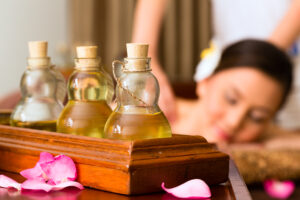 Ayurvedic cleanses generally involve eating a mono-diet of kitchari while taking cleansing herbs and performing cleansing therapies. Although this is a common practice, there are many different methods of administering the cleanse depending on the needs of the individual. Therefore it is helpful to establish your dosha type as well as any current imbalances to gain the most out of your cleanse, and more importantly, to avoid further imbalances.
Ayurvedic cleanses generally involve eating a mono-diet of kitchari while taking cleansing herbs and performing cleansing therapies. Although this is a common practice, there are many different methods of administering the cleanse depending on the needs of the individual. Therefore it is helpful to establish your dosha type as well as any current imbalances to gain the most out of your cleanse, and more importantly, to avoid further imbalances.
The most basic method for an Ayurvedic cleanse involves solely going on a kitchari fast for an allotted amount of days, typically about 3 to 7. A more in-depth cleanse will include detoxifying herbal treatments such as the Daily Detox Formula, Tikta Ghrita, and Triphala Churna. They may also include abhyanga (oil massage) using medicated oils and routine sweating through sauna or ginger-baking soda baths. These Ayurvedic formulations and practices complement the dietary cleanse, working to remove toxins at a much deeper level. With the multitude of treatment options Ayurvedic cleanses have to offer, it is important to discover the best options for your individual needs.
The first step for planning your Ayurvedic cleanse is to determine your Ayurvedic body type (i.e. Vata, Pitta, Kapha) and any doshas currently out of balance. Then you can choose a cleansing plan appropriate for you and your needs. For example, if a skinny-mini Vata type is experiencing constipation, anxiety, and dryness, their cleanse should look much different than a Kapha type experiencing heaviness, depression, sluggish metabolism, and lethargy. Therefore, this information is essential for performing an Ayurvedic cleansing program to avoid increasing the dosha and the imbalance further. So keep reading to discover how to modify your cleanse for your doshic needs!
Take our Discover your Dosha Quiz here!
Vata Kitchari Cleanse
If you have a Vata constitution or a strong Vata imbalance, then you will want to make sure your cleanse will be nourishing to Vata and the airy, spacey, kinetic qualities it possesses.
Indications for a Vata Kitchari Cleanse:
- Constipation
- Chronic gas and bloating
- Underweight
- Dryness
- Anxiety, worry, fear
- Insomnia or other restless sleep issues
- Chronic weakness or exhaustion
- Brown, grey, or black coating on the tongue
Since Vata is light and airy by nature, it is important to make sure the cleanse is not overly reducing, drying, or depleting for these sensitive individuals. Although kitchari should be the highlight of the mono-diet, it may be beneficial for Vata-types to add hearty, root veggies along with lots of warming spices, ghee, and nourishing oils. This will help to keep Vata grounded during the cleanse and prevent over-depletion. Because of this, Vata-types typically do better with shorter cleanses as well. Three to five-day cleanses may be best, especially if you are already dealing with low weight and low energy.
Try our Vata-Reducing Kitchari Recipe!
Here are some recommended products for your Vata cleanse:
- Daily Detox Formula – for burning toxins and igniting Agni (digestive fire)
- Triphala Ghrita – for internal oiliation; cleansing without increasing Vata
- Vata Massage Oil – for oil massage (abhyanga); calms Vata, loosens deep-rooted toxins, and strengthens the nervous system
- Vata Churna – Vata-soothing kitchari spice blend
- Triphala Churna – for cleansing and preventing constipation
- Ginger Bath Blend – for eliminating toxins through sweating while calming the nervous system
- Detox Tea – for boosting digestion and flushing toxins
- Dashamula Enema Kit – for calming Vata and flushing the colon
Click here for a printable PDF copy of this chart.
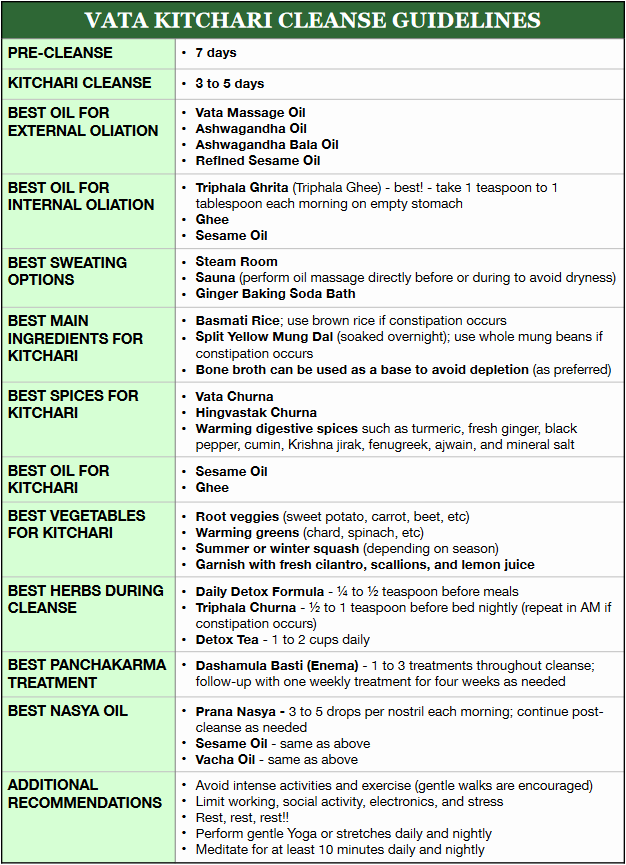
Pitta Kitchari Cleanse
If you have a Pitta constitution or a strong Pitta imbalance, you will want to make sure your cleanse will be calming to Pitta and the hot, sharp, and penetrating qualities it possesses.
Indications for a Pitta Kitchari Cleanse:
- Loose stools or diarrhea
- Hyperacidity or chronic heartburn
- Hypermetabolism
- Hypoglycemia (low blood sugar)
- Inflammation
- Excessive anger, criticism, judgment
- Skin issues such as acne, eczema, psoriasis, or rash
- Liver, gallbladder or spleen issues
- Excessive heat in the body or blood
- Yellow, orange, or reddish coating on the tongue
Since Pitta is heating by nature, it is important to ensure your cleanse is cooling, soothing, and not overly intense. Although kitchari should be the highlight of the mono-diet, it will be beneficial for Pitta-types to add cooling ingredients such as Pitta Churna, coriander, fennel, lime, cilantro, and ghee. This will help keep Pitta balanced during the cleanse without increasing heat and inflammation further. Pitta-types have medium strength constitutions and typically do best with a moderate length cleanse ranging from 5-7 days. Excessive cleansing for Pitta-predominant individuals can lead to overactive digestion, loose stools, malabsorption of nutrients, and depletion.
Try our Pitta-Reducing Kitchari Recipe!
Here are some recommended products for your Pitta cleanse:
- Daily Detox Formula – for cleansing the liver, blood, and GI tract
- Tikta Ghrita – for internal oiliaion; calms Pitta, soothes inflammation, and cool and cleanses the liver and blood
- Pitta Massage Oil – for oil massage (abhyanga); cooling formula for soothing Pitta, loosens deep-rooted toxins, and reducing inflammation
- Pitta Churna – Pitta-soothing kitchari spice blend
- Triphala Churna – for cleansing the liver and GI tract
- Ginger Bath Blend – for eliminating toxins through sweating while soothing pain and inflammation
- Detox Tea – for boosting digestion, flushing toxins, and toning the liver
Click here for a printable PDF copy of this chart.
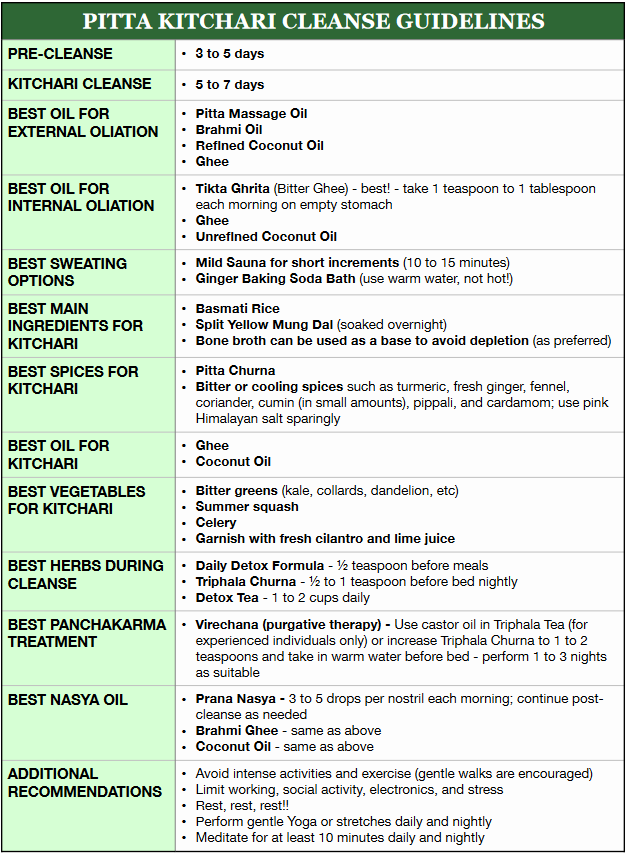
Kapha Kitchari Cleanse
If you have a Kapha constitution or a strong Kapha imbalance, you will want to make sure your cleanse is focused on reducing Kapha and the heavy, sluggish qualities it possesses.
Indications for a Kapha Kitchari Cleanse:
- Excessive weight
- Sluggish digestion, slow metabolism
- Subjective feeling of heaviness
- Dull, foggy mind
- Low motivation
- Excessive sleep
- Chronic allergies
- Chronic congestion
- Candida or chronic yeast infections
- Thick, white coating on the tongue
Since Kapha is heavy, stagnant, and dull by nature (when out-of-whack), it is important to make sure your cleanse is lightening, stimulating, and heating for this body-type. Although kitchari should be the highlight of the mono-diet, it is highly recommended to avoid all rice products including basmati or brown, as these will increase the heavy, sticky qualities that are already prevalent in most Kapha imbalances. Instead, Kapha-types tend to do best with a lighter grain such as millet or quinoa, or they can avoid grains altogether and stick to a simple mung dal and veggie soup for their mono-diet. Kapha-types need to use oil in moderation and should not exceed ½ teaspoon per meal. They should instead incorporate a copious amount of heating spices such as Trikatu, Kapha Churna, dry ginger, black pepper, and brown mustard seed. This will help to keep Kapha balanced during the cleanse, increasing Agni (digestive fire) and preventing further obstruction and heaviness. In terms of length for the Kitchari Cleanse, Kapha-types can typically handle a prolonged cleanse and should do a minimum of 7-10 days if possible.
Try our Kapha-Reducing Kitchari Recipe!
Here are some recommended products for your Kapha cleanse:
- Daily Detox Formula – for burning toxins and igniting Agni (digestive fire)
- Tikta Ghrita (use flax seed oil for high cholesterol) – for internal oiliaion; loosens deep-rooted toxins to support cleansing and strengthen Agni (digestion)
- Kapha Massage Oil – for oil massage (abhyanga); heating formula for stimulating circulation, loosening deep-rooted toxins, and reducing systemic Kapha
- Kapha Churna – Kapha-reducing kitchari spice blend
- Triphala Churna – for supporting healthy digestion and elimination
- Ginger Bath Blend – for eliminating toxins through sweating while stimulating circulation, digestion, and metabolism
- Detox Tea – for boosting digestion and flushing toxins
Click here for a printable PDF copy of this chart.
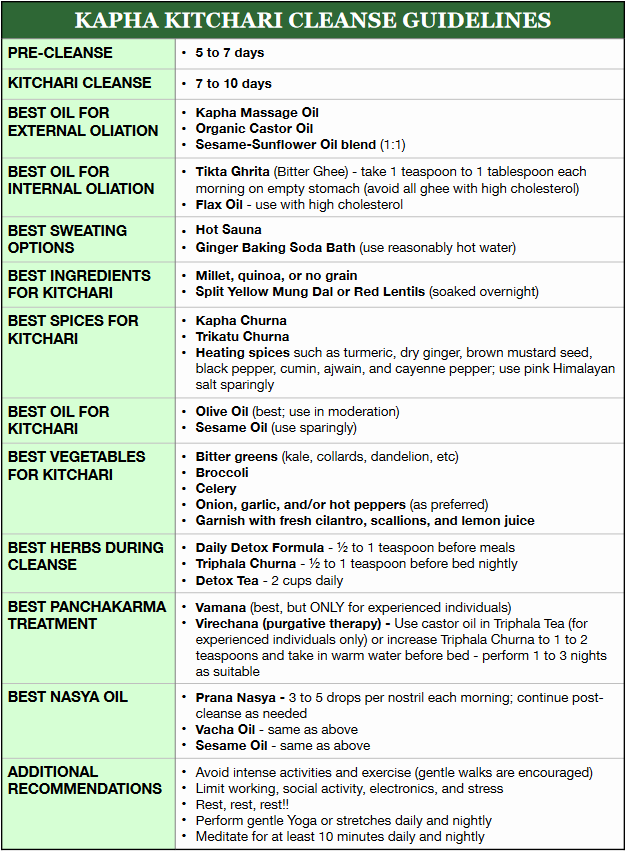

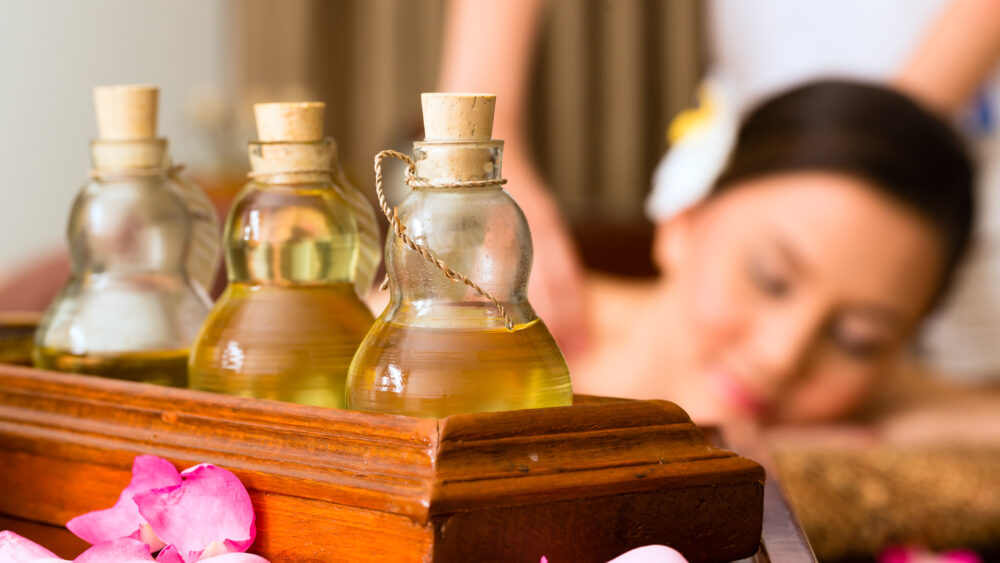
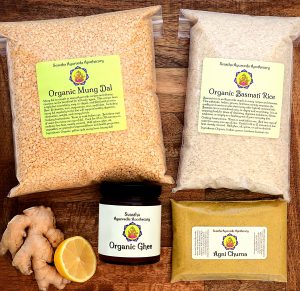
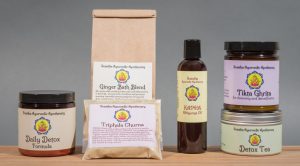

VERY USEFUL INFORMATION
THANKS
http://www.sajjanherbomed.co.in
Hi Surinder! Thank you for you kind words and thank you for reading. In love and light… Namaste, Danielle
I have pitta prakruti and vata dosha is high .Please suggest some remedies
Thanks
Hi Laxman,
Thank you for your question! I would suggest following the Vata Cleanse suggestions when it comes to the herbal suggestions. The only changes would be to avoid excessively heating spices (so a more Tridoshic blend such as our Agni Churna); you can also add some Guduchi to the enema therapy (if you are doing this therapy) to work on both doshas together.
When it comes to the ingredients for your meals, choose options that are suggested on both lists such as ghee, summer squash, and cilantro. You can use lime over lemon but avoid scallions.
If you are up for it, I would suggest performing the Virechana therapy as well. You can do this for two nights, then follow with up to three nights of the Guduchi-Dashamul enema treatments.
Let me know if you have any further questions!
Namaste,
Danielle
Thank you for this… it is amazing.
I am Kapha-Pitta and thought my imbalance was mainly kapha as I am carrying 40+ pounds that I need to shed. However, I have been having so much heartburn. What is best solution?
Thank you!
Hi Ileen! Thank you for your question. It can get a bit more complicated when multiple doshas are imbalanced at the same time. Since the heartburn is so prevalent at the moment, I would steer more towards the Pitta modifications, rather than the Kapha. I say this because Kapha being cool, congested and damp by nature needs very heating treatments in order to “melt” away the Kapha and get things moving. With all the heating oils, spices, etc it would be very likely the heartburn would flare-up. Therefore the Pitta Kitchari Cleanse will still be working to flush toxins and Kapha from the system, since it is still reducing by nature; however, it will be accomplishing this in a more balanced way for your current needs. Hope this helps! Namaste, Danielle